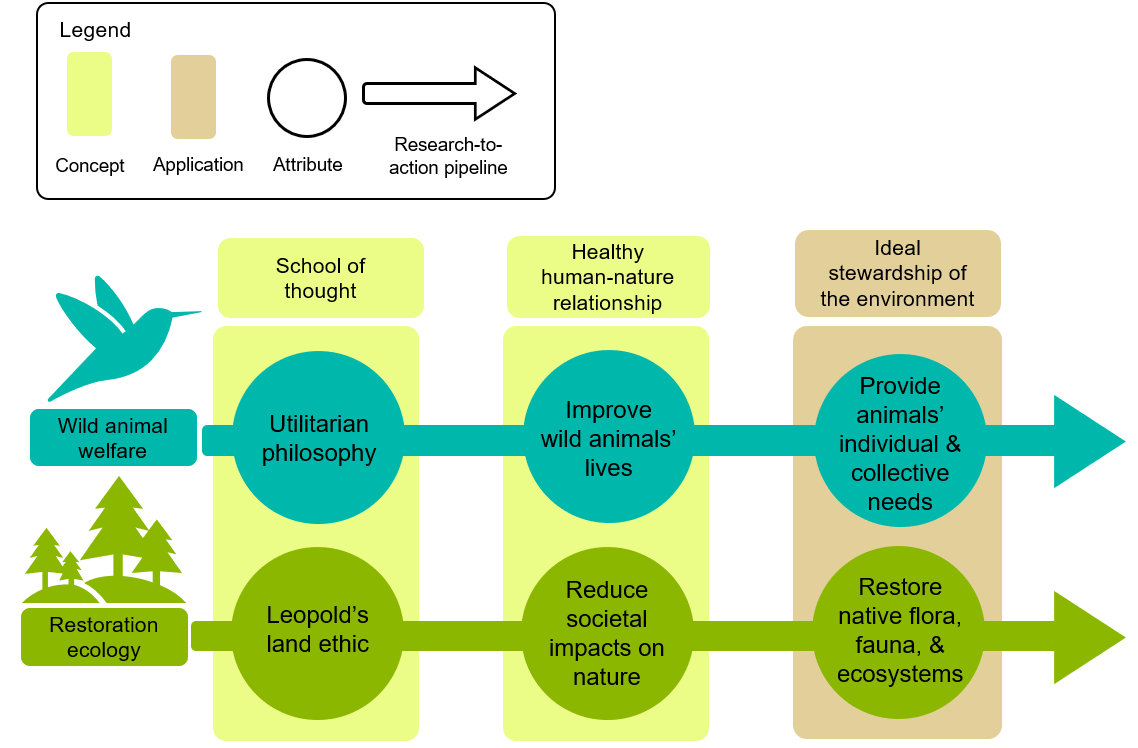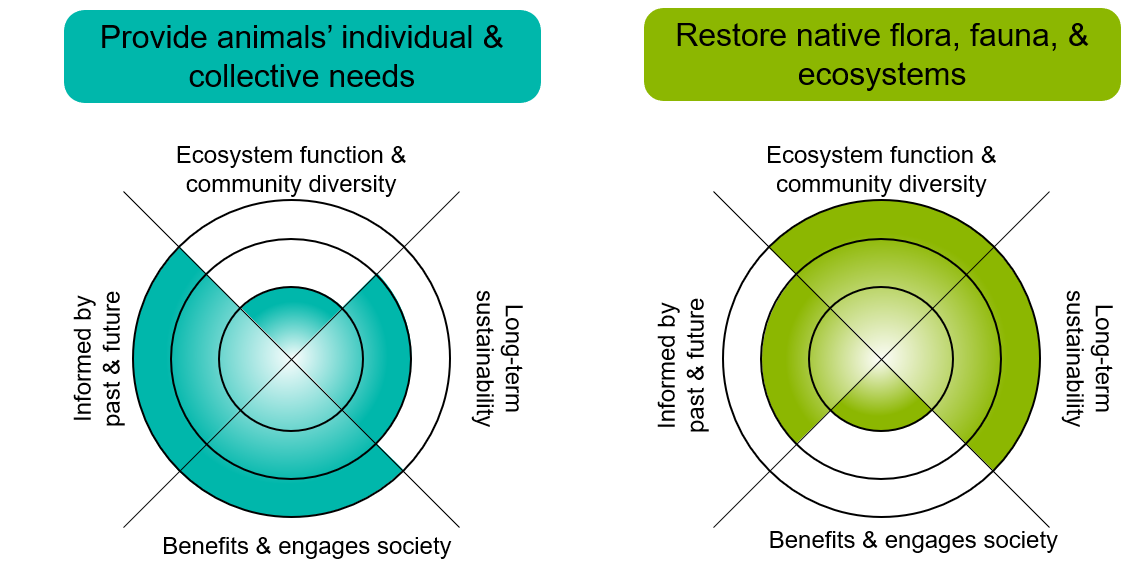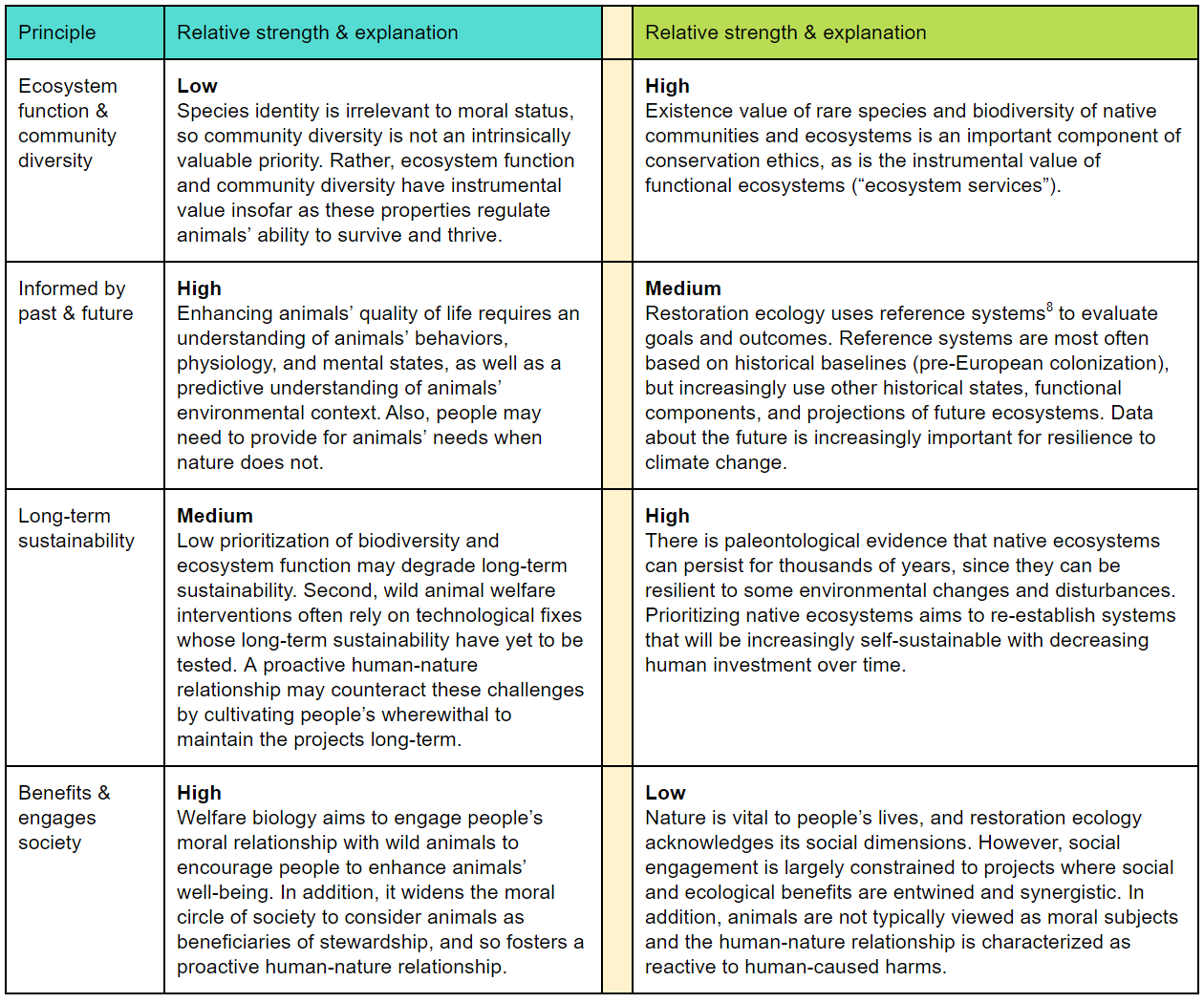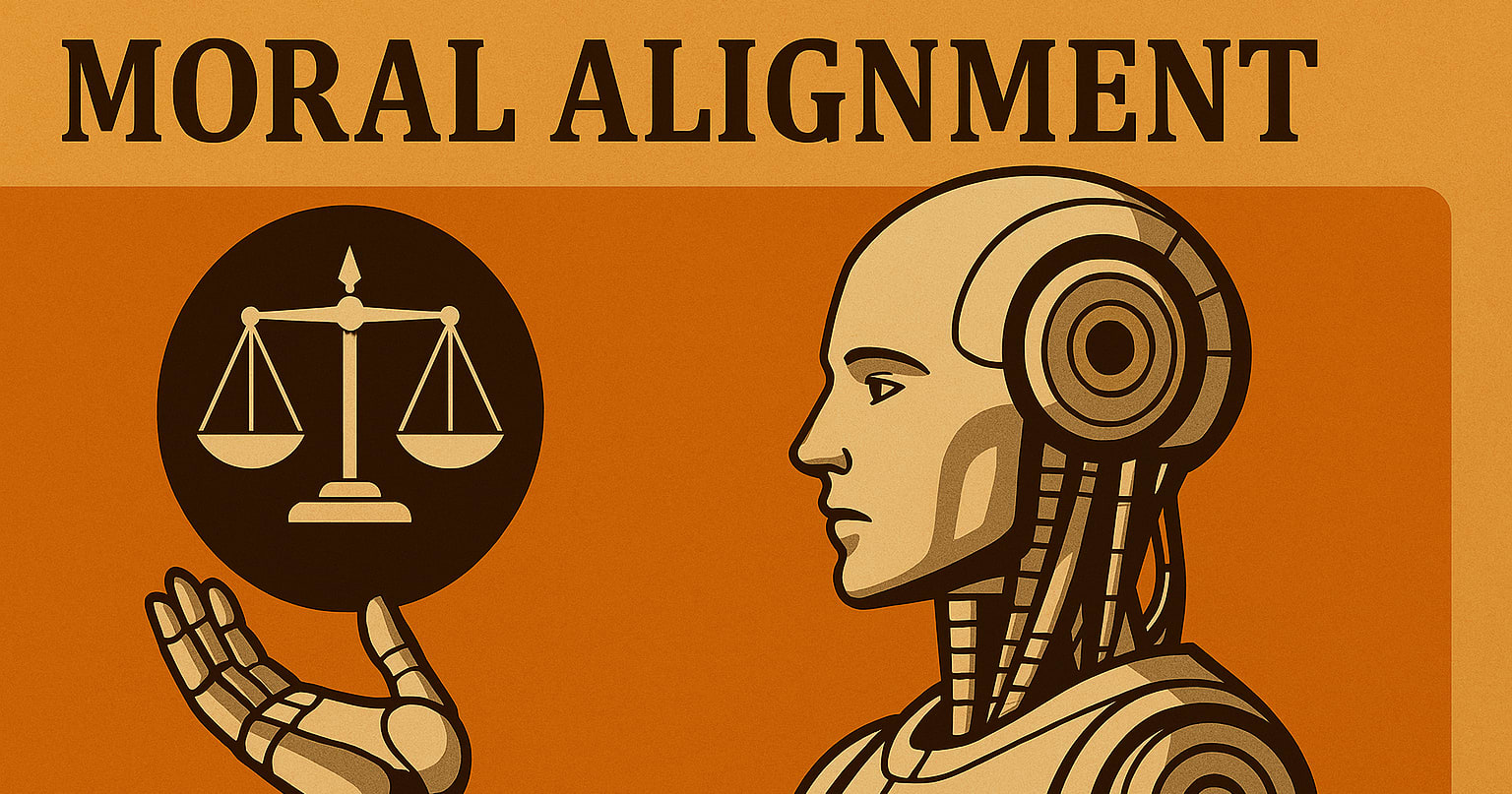Crossposted from the Wild Animal Initiative blog: https://www.wildanimalinitiative.org/blog/peopleandnature
This is a primer on the potential synergies between restoration ecology and wild animal welfare written by WAI researcher Jane Capozzelli.
Key takeaways
For a 5-min summary, see Table 1.
- The desire to build healthy human-nature relationships is a goal that is shared by restoration ecology and wild animal welfare. Both disciplines incorporate environmental stewardship into the human-nature relationship, yet have subtle differences regarding how people orient their problem-solving behavior.
- Restoration ecology can direct people to be reactive to harms on the environment. This orientation limits our ability to imagine ourselves as a part of the solution to environmental problems. In contrast, wild animal welfare calls on people to act to improve wild animals’ lives. This proactive human-nature relationship empowers people to benefit wild animals, not just exacerbate the issues they face.
- Urban wildlife diseases are an opportunity for wild animal welfare and restoration ecology to synergize. Whereas welfare biology may focus on administering vaccines and medicine to benefit wild animals directly, ecological restoration could focus on urban planning and restoration to reverse the amount of impervious surface in cities. This combined approach addresses the problem of urban wildlife diseases on two fronts.
Summary
It is crucial to cast people as active participants in ecosystems who can, and should, do more than just exacerbate environmental problems. People need the opportunity to benefit the natural world and its inhabitants. The wild animal welfare ethic empowers people to have a positive impact by defining a healthy human-nature relationship in proactive terms. Assumptions about the human-nature relationship influence stewardship goals. A wild animal welfare approach seeks to provide for animals’ individual and collective needs. In restoration ecology, the goal is to restore native flora, fauna, and ecosystems. Each project has its strengths and weaknesses in terms of prioritizing long-term sustainability, maintaining ecosystem function and community biodiversity, being informed by the past and future, and engaging and benefiting society. From a pragmatic point of view, restoration ecology and welfare biology can and should form a productive union to solve complex wildlife issues. Wildlife diseases in urban environments are an example of a transdisciplinary cause area. There are several mitigation techniques that are available today, the most salient being medicines and reducing the impervious surface in the landscape. Whereas providing wild animals with medicine is favored by the wild animal welfare community, restoration ecology has its own expertise in landscape planning and restoration. Combining these approaches reveals the potential synergy for addressing this problem. Overall, mitigating diseases in urban environments can improve the wellbeing of wild animals, as well as serve as a larger case study as to how projects for animals’ wellbeing can complement traditional modes of environmental management.
Article
Both restoration ecology and wild animal welfare aim to build healthy relationships between humans and nature in order to inspire people to steward the natural world.[1][2] What is a healthy human-nature relationship? The concept is value-laden along two lines: the type of relationship between humans and nature and how to make the relationship healthy once it has formed.
The type of human-nature relationship that is advanced varies between welfare biology and restoration ecology. The difference arises because the two disciplines have emerged from different schools of thought. The wild animal welfare movement often draws upon utilitarian philosophy: doing as much good for as many sentient beings (human and nonhuman animals) as possible.[3] Restoration ecology is informed by Leopold’s land ethic,[4] which blends an intrinsic value of nature with the instrumental value of ecosystems to support nonhuman and human life. It is worth noting that both disciplines contain pluralistic ethics[5][6] and that the utilitarian school of thought is also not exclusive to animal welfare, as conservation also uses consequentialism.[7] Regardless, the dominant value systems usually advance subtly different roles for people in nature (Fig. 1).
Figure 1. Parallel ideas in wild animal welfare and restoration ecology.
Restoration ecology’s goal of “reduc[ing] societal impacts on the natural world”[8] implies a reactive relationship between people and nature, in which people react to environmental degradation and help return ecosystems to their natural function. One common restoration tool is the natural (or spontaneous) regeneration approach, in which the source of environmental degradation is removed and no additional interventions alter the recovery trajectory.[8:1] The prescription has an ecological basis, as ecosystems do have a natural ability to recover and remain functioning. Yet, characterizing people’s ideal role with nature in this way, as only reactive to human-caused harm, limits our ability to be helpful stewards of nature. This blindspot is elegantly described by the ecologist Robin Wall Kimmerer, who surveyed her class of advanced environmental-studies students:
“They were asked to rate their understanding of the negative interactions between humans and the environment. Nearly every one of the two hundred students said confidently that humans and nature are a bad mix… Later in the survey, they were asked to rate their knowledge of positive interactions between people and land. The median response was ‘none.’ I was stunned. How is it possible that in twenty years of education they cannot think of any beneficial relationships between people and the environment? …When we talked about this after class, I realized that they could not even imagine what beneficial relations between their species and others might look like. How can we begin to move toward ecological and cultural sustainability if we cannot even imagine what the path feels like?”[9]
It is crucially important to cast people as active participants in ecosystems so that people have the opportunity to benefit the natural world and its inhabitants. As active participants in ecosystems, people can and should imagine themselves as long-lasting solutions to a wide range of environmental problems. Infusing proactive qualities into human-nature relationships is key to making these relationships healthy.[9:1][10] Wild animal welfare is one such ethic that defines a human-nature relationship as healthy when it is proactive. The ethic of wild animal welfare asks people to act to improve wild animals’ lives, not just exacerbate the issues they face. This call to action empowers people to have a positive relationship with wildlife by enhancing animals’ quality of life.
To improve the quality of life of a free-living animal, one ideal project from the ethic of wild animal welfare is to provide for animals’ individual and collective needs.[11] In contrast, the ideal example of environmental stewardship in restoration ecology is to restore native flora, fauna, and ecosystems.[8:2] To illustrate the differences between these projects, I compared them using a set of four principles put forward in the restoration literature: 1) ecosystem function and community diversity, 2) long-term sustainability, 3) informed by past and future, and 4) benefits and engages society.[12] These four categories can be used to articulate and outline the priorities and trade-offs that are generally important to consider in environmental stewardship projects. When viewed side by side, we can begin to understand how wild animal welfare projects differ from traditional stewardship projects in conservation and restoration ecology, as well as infer each discipline’s relative strengths.
Figure 2. Relative strengths of ideal environmental stewardship projects in wild animal welfare (left) and restoration ecology (right). Adapted from Suding et al. (2015).
Table 1. Explanation of relative strengths of ideal environmental stewardship projects in wild animal welfare and restoration ecology. Principles chosen following Suding et al. (2015).
No one discipline can be expected to optimize every angle, especially for multidimensional environmental problems. From a pragmatic point of view, restoration ecology and welfare biology can and should form a productive union to solve complex wildlife issues. One transdisciplinary cause-area is wildlife diseases in urban environments. Risk of disease is acute in urban environments because of four factors: urban-animal community dynamics, animal behavior, landscape patterns, and human activities.[13]
Human travel, for example, introduces and spreads novel pathogens throughout the globe, and our habit of keeping domestic pets exposes wildlife to disease. The human density in cities magnifies these negative effects. Dense human habitation also alters the landscape pattern, as the transportation, infrastructure, and industrial sectors tend to increase in cities. This increase has two direct impacts. First, an increase in pollution and toxins to the environment. Second, landcover changes from living features to a dominance of impervious surfaces (concrete structures).[13:1]
Because most species cannot adapt to an environment dominated by concrete, an increase in impervious surface correlates with biotic homogenization—the loss of native biodiversity and a concomitant hyperabundance of a few well-adapted species, such as mice, rats, grey squirrels, starlings, and house sparrows. The behaviors of these animals, in turn, make them more susceptible to disease. These animals tend to live communally and cluster around food resources, and so transmit pathogens amongst each other at an unusually high rate. Urban-adapted animals are also atypical in their ability to habituate to people. As a result, they live in unusually-close proximity to the novel pathogens and pollutants that are the byproducts of dense settlements and human activities.[13:2]
These disease dynamics are complex, and there are several more factors at the landscape scale and the scale of the individual animals themselves that I do not describe here. Nevertheless, there are several mitigation techniques that are available today, and could be made more accessible in the future: vaccines, medicines, and landscape planning, particularly reducing the spatial extent of impervious surfaces by planting beneficial vegetation and building parks or wildlife corridors.[13:3] The most ethical and effective strategies to mitigate wildlife diseases have yet to be determined. More work is needed to evaluate how much they reduce disease risk in any particular context, as well as how these methods impact the wellbeing of individual animals and the net-welfare of an animal community in the long term.
Each strategy listed is, at least, an expression of a healthy human-nature relationship in which people help wild animals survive and thrive. The wild animal welfare community favors providing animals with vaccines and medicines, whereas the restoration community looks to reverse biotic homogenization and restore natural landscape features. When approaches from the ethic of wild animal welfare and restoration ecology are combined, the potential for synergy to address environmental problems is revealed. Ultimately, mitigating diseases in urban environments can serve as a larger case study as to how projects for animals’ wellbeing can complement other types of environmental management, in addition to simply improving the wellbeing of a vast number of wild animals.
References
Dunn RR, Gavin MC, Sanchez MC, Solomon JN (2006) The pigeon paradox: dependence of global conservation on urban nature. Conservation Biology 20:1814-1816 ↩︎
Heberlein TA (2012) Navigating environmental attitudes. Oxford University Press, New York, New York ↩︎
Singer P (2001) Practical ethics. Third edition. Cambridge University Press, New York, NewYork ↩︎
Leopold A (1966) The land ethic. Pages 237–264. In: A Sand County almanac with essays on conservation from Round River. Oxford University Press, New York ↩︎
Fraser D (2008) Understanding animal welfare. Acta Veterinaria Scandinavica 50:S1 In: The role of the veterinarian in animal welfare. Animal welfare: too much or too little? The 21st Symposium of the Nordic Committee for Veterinary Scientific Cooperation (NKVet). 24-25 September 2007. Værløse, Denmark ↩︎
Robinson JG (2011) Ethical pluralism, pragmatism, and sustainability in conservation practice. Biological Conservation 144:958-965 ↩︎
Johnson PJ, Adams VM, Armstrong DP, Baker SE, Biggs D, Boitani L, Cotterill A, Dale E, O’Donnell H, Douglas DJ, Droge E et al. (2019) Consequences matter: compassion in conservation means caring for individuals, populations, and species. Animals 9:1115 ↩︎
Gann GD, McDonald T, Walder B, Aronson J, Nelson CR, Jonson J, et al. (2019) International principles and standards for the practice of ecological restoration. Second edition. Restoration Ecology 27:S1–S46 ↩︎ ↩︎ ↩︎
Kimmerer RW (2013) Braiding sweetgrass: indigenous wisdom, scientific knowledge, and the teachings of plants. Milkweed Editions. Minneapolis, Minnesota, USA ↩︎ ↩︎
Allison SK (2007) You can’t not choose: embracing the role of choice in ecological restoration. Restoration Ecology 15:601-605 ↩︎
Sebo J (2020) All we owe to animals. Aeon, 15 January 2020 https://aeon.co/essays/we-cant-stand-by-as-animals-suffer-and-die-in-their-billions [Accessed 3 March 2020] ↩︎
Suding K, Higgs E, Palmer M, Callicott JB, Anderson CB, Baker M, Gutrich JJ, Hondula KL, LaFevor MC, Larson BMH, et al. (2015) Committing to ecological restoration. Science 348:638-640 ↩︎
Bradley CA, Altizer S (2006) Urbanization and the ecology of wildlife diseases. Trends in Ecology and Evolution 22:95-102 ↩︎ ↩︎ ↩︎ ↩︎







Agreed! I appreciate the correction.
Thanks for sharing Catia's dissertation! I hadn't seen that before and I'm looking forward to reading it.